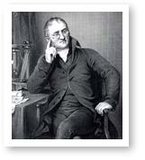Dalton, John (Environmental Law & Policy)

Dalton, John
John Dalton (1766–1844) was born into a modest Quaker family in Cumberland, England, and earned his living for most of his life as a teacher and public lecturer, beginning in his village school at the age of 12. After teaching 10 years at a Quaker boarding school in Kendal, he moved on to a teaching position in the burgeoning city of Manchester. There he joined the Manchester Literary and Philosophical Society, which provided him with a stimulating intellectual environment and laboratory facilities. The first paper he delivered before the society was on color blindness, which afflicted him and is sometimes still called "Daltonism."
Dalton arrived at his view of atomism by way of meteorology, in which he was seriously interested for a long period: he kept daily weather records from 1787 until his death, his first book was Meteorological Observations (1793), and he read a series of papers on meteorological topics before the Literary and Philosophical Society between 1799 and 1801. The papers contained Dalton's independent statement of Charles's law (see Joseph Louis Gay-Lussac): "All elastic fluids expand the same quantity by heat." He also clarified what he had pointed out in Meteorological Observations—that the air is not a vast chemical solvent as Antoine-Laurent Lavoisier and his followers had thought, but a mechanical system, where the pressure exerted by each gas in a mixture is independent of the pressure exerted by the other gases, and where the total pressure is the sum of the pressures of each gas. In explaining the law of partial pressures to skeptical chemists of the day—including Humphry Davy—Dalton claimed that the forces of repulsion thought to cause pressure acted only between atoms of the same kind and that the atoms in a mixture were indeed different in weight and "complexity."
He proceeded to calculate atomic weights from percentage compositions of compounds, using an arbitrary system to determine the likely atomic structure of each compound. If there are two elements that can combine, their combinations will occur in a set sequence. The first compound will have one atom of A and one of B; the next, one atom of A and two atoms of B; the next, two atoms of A and one of B; and so on. Hence, water is HO. Dalton also came to believe that the particles in different gases had different volumes and surrounds of caloric, thus explaining why a mixture of gases—as in the atmosphere—would not simply layer out but was kept in constant motion. Dalton consolidated his theories in his New System of Chemical Philosophy (1808–1827).
As a Quaker, Dalton led a modest existence, although he received many honors later in life. In Manchester more than 40,000 people marched in his funeral procession.
Further Reading
- Biography of John Dalton, Salt Lake Community College.
- Chemical Achievers: John Dalton, Chemical Heritage Foundation.
- Dalton's Atomic Theory, Indiana University Northwest.